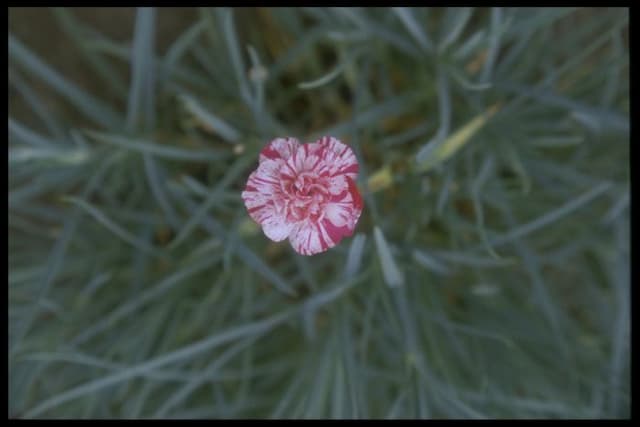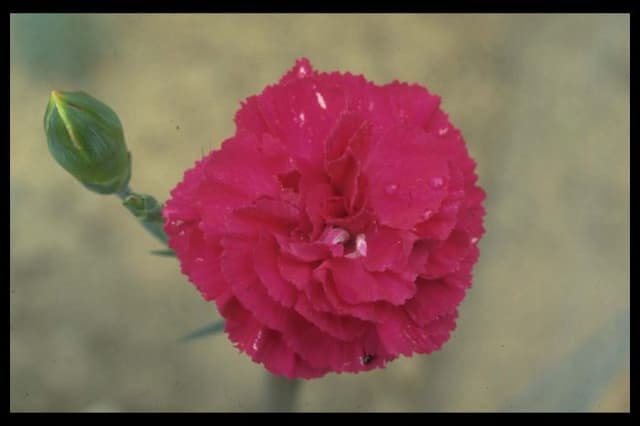White Rose Campion Lychnis coronaria 'Alba'

ABOUT
Lychnis coronaria 'Alba', commonly known as white rose campion, is a striking perennial known for its contrasting foliage and flowers. The plant features a basal rosette of soft, downy, silvery-grey leaves that are lance-shaped and possess a velvety texture. The foliage serves as a beautiful backdrop for the plant's most striking feature: its delicate, pure white flowers. These blooms are composed of five notched petals and form a simple yet elegant shape that resembles a blushing bride's crown. Each flower is held aloft on slender, upright stems that are studded with similar grey-green, woolly leaves that get smaller as they ascend. The white rose campion's blooms are particularly known for their papery, almost ethereal quality that can add a luminous glow to garden settings in the right light. The contrast between the white of the flowers and the silver-grey of the foliage creates a dramatic and attractive display, making it a favorite among gardeners looking to add visual interest without the use of bold colors.
About this plant
 Names
NamesFamily
Caryophyllaceae.
Synonyms
White Campion, White Cockle, Silene coronaria ‘Alba’, Rose Campion ‘Alba’.
Common names
Silene coronaria 'Alba', Agrostemma coronaria 'Alba'
 Toxicity
ToxicityTo humans
Rose campion is generally not considered toxic to humans. There are no well-documented cases of poisoning from ingesting rose campion. However, as with many plants, it is advisable not to eat any part of plants that are not known to be edible, as they may cause gastrointestinal discomfort or an allergic reaction in some individuals. There is no prominent literature suggesting that this plant presents any significant risk of toxicity when touched or ingested in small quantities by humans.
To pets
Rose campion is not commonly listed as a toxic plant for pets such as dogs and cats. However, as with any non-food plant, consumption in large amounts could potentially lead to gastrointestinal upset such as vomiting or diarrhea due to the plant material's irritant properties. It is always a good practice to keep an eye on pets and discourage them from eating ornamental plants, as individual sensitivity can vary and what is non-toxic for one animal may still cause a mild reaction in another.
 Characteristics
CharacteristicsLife cycle
Perennials
Foliage type
Deciduous
Color of leaves
Silver-grey
Flower color
White
Height
2-3 feet (60-91 cm)
Spread
1-2 feet (30-60 cm)
Plant type
Herb
Hardiness zones
4-8
Native area
Europe
Benefits
 General Benefits
General Benefits- Attracts Pollinators: The white flowers of Lychnis coronaria 'Alba', commonly known as White Campion, are known to attract bees and butterflies, which are essential for pollination.
- Drought Resistance: Once established, this plant is remarkably drought-tolerant, making it a good choice for gardens in arid climates or areas with water restrictions.
- Low Maintenance: White Campion is considered low maintenance, requiring minimal care once established, which can save time and effort for gardeners.
- Deer Resistant: The plant is often resistant to deer, making it a good choice for gardens in areas with a high deer population.
- Long Blooming Season: White Campion has a long blooming period from early summer to early fall, providing extended visual interest in the garden.
- Cottage Garden Appeal: With its soft white flowers and gray-green foliage, it contributes to the quintessential cottage garden aesthetic, popular among garden enthusiasts.
- Self-seeding: Lychnis coronaria 'Alba' can self-seed under the right conditions, potentially providing new plants each year without additional cost or effort.
- Ornamental Foliage: The silvery-gray foliage provides a decorative element to the garden, adding contrast and complementing surrounding plants even when not in bloom.
- Edging and Borders: Due to its compact and clumping growth habit, White Campion is well-suited for use in garden edging and as a border plant.
- Wildlife Habitat: The plant can serve as habitat for beneficial insects, contributing to overall garden ecosystem health.
 Medical Properties
Medical PropertiesThis plant is not used for medical purposes.
 Air-purifying Qualities
Air-purifying QualitiesThis plant is not specifically known for air purifying qualities.
 Other Uses
Other Uses- As an artist's muse: Lychnis coronaria 'Alba', or White Rose Campion, with its striking white flowers, can serve as an inspirational subject for painters and photographers looking to capture the essence of delicate floral beauty.
- Educational tool in botany: The distinct morphology of White Rose Campion can help students learn about plant structure, flower arrangement, and pollination strategies in educational settings.
- Companion planting: White Rose Campion is sometimes used in companion planting to attract beneficial insects like bees and butterflies for pollination of surrounding crops.
- Theme gardens: This plant is utilized in thematic garden designs, such as white gardens or moon gardens, due to its luminous white blossoms that stand out in low light conditions.
- Floral arrangements: While not a traditional cut flower, the bold silhouette and striking color of White Rose Campion makes it suitable for use in contemporary floral designs and bouquets.
- Crafts and dyeing: The bright petals of White Rose Campion have historically been used to create natural dyes for fabrics and other crafts, although this is less common now.
- Culinary garnish: Although not a common practice, the flowers can be used to add visual flair to salads and desserts, provided they are sourced from a non-toxic and pesticide-free environment.
- Seasonal celebrations: In some cultures, the plant may be used as part of floral arrangements and decorations for specific festivals or celebrations that occur when the plant is in bloom.
- Garden boundary definition: White Rose Campion can serve a practical function by providing a natural, soft border along walkways or between different sections of a garden.
- Sensory gardens: The velvety texture of the plant's leaves can add an additional tactile element to gardens designed to stimulate the senses.
Interesting Facts
 Feng Shui
Feng ShuiThe Rose Campion is not used in Feng Shui practice.
 Zodiac Sign Compitability
Zodiac Sign CompitabilityThe Rose Campion is not used in astrology practice.
 Plant Symbolism
Plant Symbolism- Romance: The common name of Lychnis coronaria 'Alba' is Rose Campion. Its alluring white blossoms are reminiscent of pure love and deep affection, often used to express romantic feelings.
- Admiration: The bright white flowers stand out in the garden, symbolizing admiration and the charm of something or someone that captivates your attention.
- Purity: White flowers, including the Rose Campion 'Alba', are traditionally associated with innocence and purity, making them a suitable choice for weddings and similar occasions.
- Survival: Rose Campion is known for its hardiness and ability to thrive in poor soils, representing resilience, survival, and the ability to prosper in challenging conditions.
- Protection: Historically, some believed that Rose Campion had protective qualities, planting them around houses to ward off evil spirits or misfortune.
 Water
WaterRose Campion should be watered deeply and infrequently, allowing the soil to dry out between waterings to prevent root rot. In general, watering once a week with 1-2 gallons of water is sufficient, but this may vary based on temperature and soil conditions. During hot and dry spells, the plant may require additional water. It's best to water early in the morning at the base of the plant to avoid wetting the foliage, which can lead to fungal diseases. It's important to monitor the plant and adjust watering based on its health and the weather.
 Light
LightRose Campion thrives best in full sun, meaning it should receive at least 6-8 hours of direct sunlight each day. The ideal spot for planting Rose Campion is an area with unobstructed sunlight that mimics its natural habitat. However, in regions with extremely hot summers, the plant can benefit from some light afternoon shade to prevent stress from intense heat.
 Temperature
TemperatureRose Campion can survive a wide range of temperatures, typically enduring winter cold down to about -20 degrees Fahrenheit and summer highs well above 90 degrees Fahrenheit. The ideal growing temperature is between 60 and 75 degrees Fahrenheit. These temperature ranges enable the plant to grow and bloom successfully.
 Pruning
PruningPruning Rose Campion is mainly done to maintain its shape and encourage more blooms. Deadhead spent flowers regularly to promote continuous blooming throughout the season. Cut back the foliage to ground level in late fall or early winter after the plant has died back to tidy the area and encourage fresh growth in the spring. Pruning is typically done annually.
 Cleaning
CleaningAs needed
 Soil
SoilRose Campion (Lychnis coronaria 'Alba') thrives best in well-draining soil enriched with organic matter; a mix of garden soil, compost, and sharp sand is ideal. This plant prefers a neutral to slightly alkaline pH, around 6.5 to 7.5.
 Repotting
RepottingRose Campion is a biennial or short-lived perennial that does not typically require frequent repotting. It is often treated as a self-seeding annual, so repotting can be done if needed when plants are young or when dividing overcrowded clumps every few years.
 Humidity & Misting
Humidity & MistingRose Campion prefers average to low humidity conditions. High humidity levels are not necessary for this plant and can sometimes lead to fungal diseases, so it fares well in typical outdoor environments without supplemental humidity.
 Suitable locations
Suitable locationsIndoor
Grow Rose Campion indoors with bright indirect light and good air circulation.
Outdoor
Plant in full sun to part shade, well-draining soil, and water moderately.
Hardiness zone
4-8 USDA
 Life cycle
Life cycleLychnis coronaria 'Alba', commonly known as White Rose Campion, begins its life cycle as a seed, typically sown in late spring or early summer. Upon germination, which requires light, the seedling emerges and develops a rosette of fuzzy, silver-white foliage at the soil level. Through its first growing season, the plant focuses on vegetative growth, establishing a sturdy root system. In its second year, the White Rose Campion sends up tall flower stalks, which can reach up to 2-3 feet, bearing pristine white, open-petaled flowers that attract bees and butterflies. After blooming from early to mid-summer, the plant sets seed, dispersing them around the parent plant or further afield by wind or animal movement. The plant typically completes its life cycle by dying back after seed set, though it can behave as a short-lived perennial or biennial, possibly re-emerging from the rootstock or self-seeding for the next season.
 Propogation
PropogationPropogation time
Spring to early summer
The most popular method of propagation for the Lychnis coronaria 'Alba', commonly known as White Cockle or Rose Campion, is by seed. Sow the seeds directly in the garden shortly before the last expected frost in spring. Sprinkle the seeds onto prepared soil and lightly press them in, as they need light to germinate. Keep the soil moist but not waterlogged. Germination typically occurs within two to three weeks. Once seedlings are large enough to handle and have developed true leaves, they can be thinned out or transplanted to their final positions in the garden, spacing them about 12 to 18 inches (approximately 30 to 45 centimeters) apart to give them enough room to grow.






![Pink [Coconut Sundae]](/_next/image?url=https%3A%2F%2Fplants-admin.emdemapps.com%2Fimages%2Fplants%2F%2Fimages%2F604b5d09d4fd1.png&w=640&q=75)


